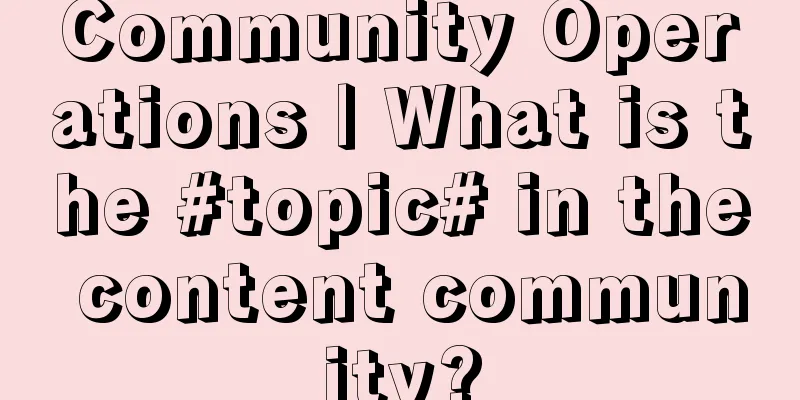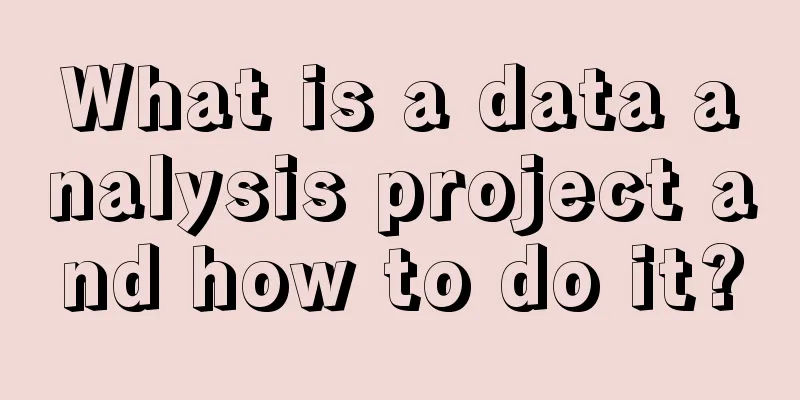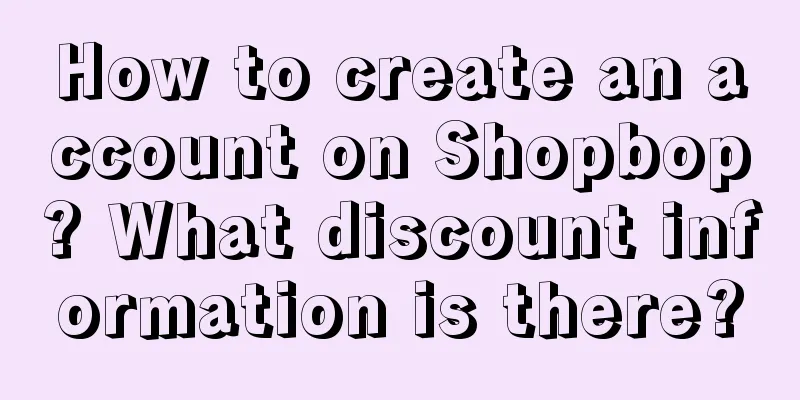Community Operations | What is the #topic# in the content community?

Author: Darry Source: WeChat public account "SuperDarry (ID: super_darry)" What is #topic#?In real life, a topic is the center of a conversation, but it is not limited to the center of a conversation. People will have various opinions on the same issue, and these opinions plus the issue form a topic. In the Internet world, Hashtag, as one of the most important features of Twitter, was born in 2007. It allows users to create a topic tag for information in order to collect discussions and exchanges on topics among online users across the platform, thereby aggregating and categorizing huge and complex information. When it comes to the aggregation and classification of content, it is easy to think of similar words such as "channel" and "circle", so what is the difference between topics, channels and circles? Simply put, in addition to product form, the differences between topics, channels, and circles are mainly reflected in the granularity and freedom of aggregated content. Channels are relatively easy to explain, and are coarse-grained content categories specified by the platform. The main form of circles is to gather people in the same circle through a theme. There are strong connections within the circle, and weak connections between circles. Each circle is a relatively independent and stable group with its own communication methods and culture. However, there are barriers between circles, and information is difficult to circulate. Douban Group Topics also seem to aggregate people and content through themes. But the difference is that topics have smaller granularity and higher degrees of freedom. They can be events, activities, habits, etc., and are usually a way of aggregating content with timeliness. Users can efficiently obtain a large amount of similar content across circles through topics. There is a core premise here: high-quality content can break through circles. Topics can enable high-quality content to spread quickly through more and more stable distribution channels, improve the information circulation and user activity of high-quality content, and enable it to break through the barriers between circles. Therefore, topics can complement circles very well, which will be explained in detail later. Why do content communities need #topics#?All content communities must solve the problem of "where does the content come from and where does it go". So, first of all, how can users actively produce high-quality content? There are two key words here, initiative and quality. Before the user's mind is formed, the platform needs a good mechanism to guide users to produce content. One way to motivate users is through activities. Compared with topics, the initiator of an activity can usually achieve better results in the short term. However, for the platform, since activities are usually topic-based, it is difficult to guide users to continue to actively produce content, and it requires continuous operating costs. The free topic mechanism can well guide users to produce high-quality content under topics of interest, and users' temporary content publishing will get long-term effective exposure under the topic. For users, this not only reflects self-expression, but also has the expectation of gaining resonance, which can easily form a long-term sharing mentality. #DailyOutfit# topic on Xiaohongshu The essence of a community is the connection between people and content. Once we have high-quality content, how can we distribute it effectively? We know that there are usually three ways for users to obtain content in content communities: recommendation, search, and active exploration . Excellent content distribution requires ensuring the matching degree of content. The finer the granularity, the more accurate the content matching can be. High matching degree can bring high user interaction enthusiasm, which is a positive cycle for the community ecology. Topics can play a huge role in these three forms of content distribution.
The hashtag aggregation effect of Twitter and Weibo reflects the important information value when major events occur: it may be the first intelligence station for celebrity dynamics, or it may be a public discussion area for social events. For current hot topics, it is convenient for users to see more user content and comments. Topics about typhoons on Weibo Topics are also a good commercial capability. The above-mentioned activities are often used for the commercialization of topics. Usually, advertisers initiate a topic, and KOLs drive users to participate in the activity and publish content, which will generate long-term recognition of the brand or short-term purchasing behavior. Commercialization of Weibo Topics How to design #topics# for community products?Every iteration of community products needs to focus on community content and user status, with content and users as the core. Whether it is the modification of publishing functions, topics or circle mechanisms, it will affect the essence of community content. Therefore, what are the problems in the community today? What impact will the new mechanism have on the community ecology? Does this meet the community's goals and vision? These questions need to be thought through before each product iteration. When does a content community need a topic mechanism? My understanding is that when the content categories of a community are no longer concentrated and cannot be covered by simple channels and circles, topics are needed as a bridge to connect the content. The strongest product mechanism of Jike is circles, and the strongest product mechanism of Xiaohongshu is recommendations. Both products chose to launch the topic mechanism when the existing mechanism could not meet the speed of content expansion. The most important thing about a topic is to achieve "globality", which is the premise for maximizing the topic effect. Topics are usually a complement to other forms of community distribution, serving as a global connection of related content. For current community products, the mechanism of combining circles and topics has gradually become a trend, such as Jike (once again expressing my longing for Jike), bilibili, Feiliao, Tieba, etc. The advantage of circles + topics is that circles and topics will both be important content distribution nodes. The content within circles can be stably spread vertically through circleization, and high-quality content can break through circle barriers and spread horizontally. Long-tail circles and hot topics can coexist harmoniously in the community. The relationship between circles and topics is like a grid. A complete community ecology should ensure the free flow of content as much as possible and ultimately achieve an efficient connection between content and people. If a community wants to accommodate sufficiently long-tail and massive content, it must provide a variety of content organization methods to enable users to produce and obtain content in a long-term, stable and efficient manner. Thanks for reading, I hope this helps you. Author: Darry Source: WeChat public account "SuperDarry (ID: super_darry)" The title image is from Unsplash, based on the CC0 protocol |
<<: 15,000 words sharing丨How to build a user growth system?
>>: How to operate community content? Tiantian Fund has the answer!
Recommend
How to set up Shopee store ads? Tips
This article will show you some tips on how to set...
The rise of branded short dramas: explosive content and high-quality marketing build a new era of content ecology
Starting from short plays, this article analyzes t...
Deconstruction before reconstruction
Through two vivid stories, this article explores h...
What did the small websites miss during the 618 chaos?
During the 618 e-commerce promotion, the advertisi...
As the Metaverse moves forward, digital marketing trends that brands need to pay attention to in 2023
For brands, the Metaverse is a huge "blue oce...
How to pay Amazon's European VAT tax? How to declare VAT?
To open a store on Amazon Europe, merchants need t...
Mixue Ice City turns "green", the Snow King has the traffic code
This article first introduces what happened recent...
This [User Behavior Analysis] guide is so professional!
What should you do if there are too many user beha...
How to remove variants on Amazon? What are the effects of Amazon deleting the parent?
In the operation process of Amazon, the setting an...
How to join Shopee? What are the conditions for opening a store?
Shopee is a platform that many merchants have aske...
When is the best time to change jobs?
In the workplace, job hopping is a common thing, b...
How is Shopify Japan? What is the magic of Shopify?
Shopify is suitable for cross-border e-commerce to...
Top 10 marketing failure cases in 2023, don’t fall into the trap of brand marketing again!
This article reviews the marketing strategy failur...
How to set up a payment account on Shopee? Which payment account should I choose?
Shopee platform is one of the most promising platf...
The value of private domain users has doubled! How can a small private domain create a large increase?
This article mainly discusses how a small-scale pr...

![[Special Topic on Strategic User Research] The End of User Research is Strategic User Research](/upload/images/67e6f606cab2b.webp)







